- Moative
- Posts
- The MIT Report on Enterprise GenAI adoption Is a Nothing-burger
The MIT Report on Enterprise GenAI adoption Is a Nothing-burger
Progress isn’t loud; it compounds quietly in production.
MIT’s NANDA Report on Enterprise GenAI adoption is the talk of the town. Understandably, the headline (“Only 5% of enterprise GenAI custom projects went to production”) echoed at several ‘Teams’ calls. Microsoft Copilot, the silent and useless fly on the wall in these meetings, would have had the same melt-down that Sydney did, had it not been for the perfectly working enterprise guardrails.
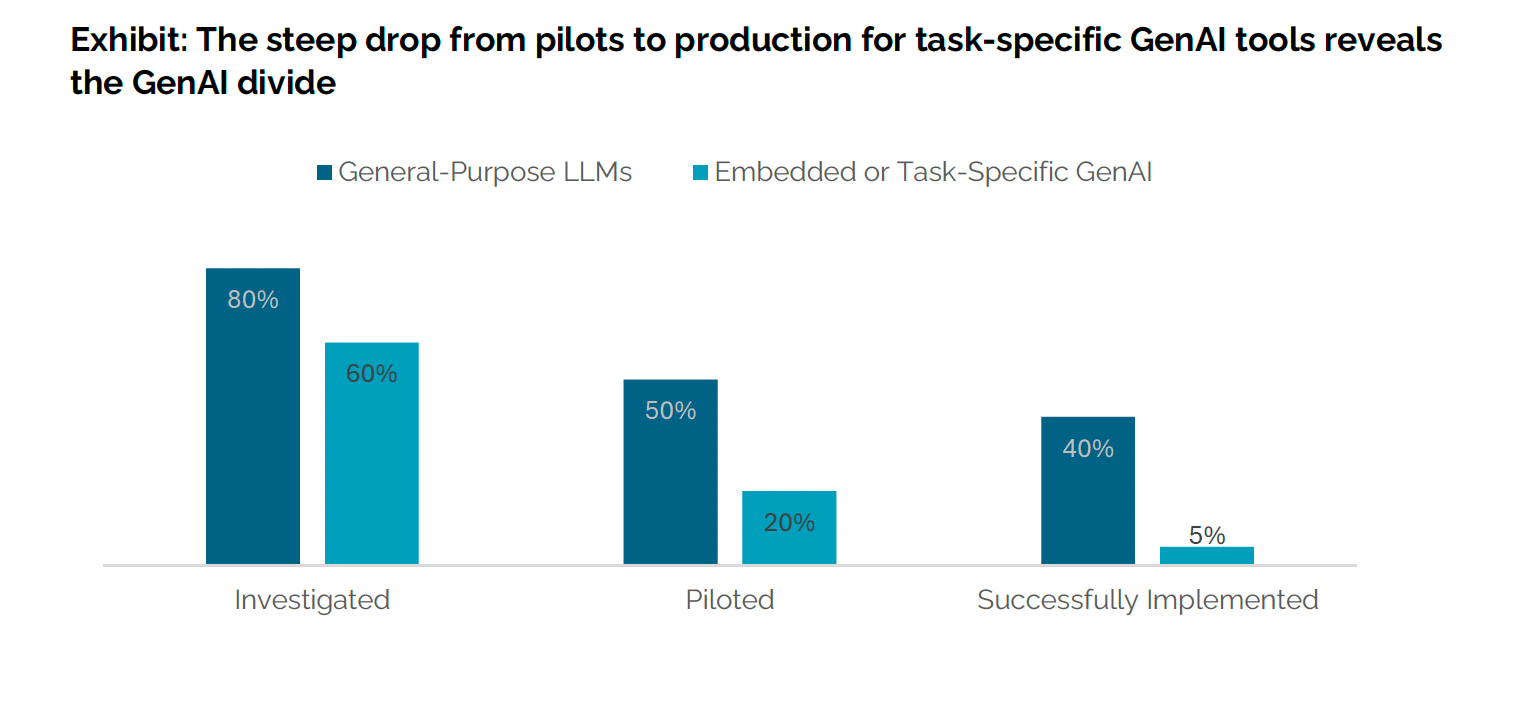
No. 95% did not fail
If your existence at work is usually about dropping early from one Teams call and joining late on another, I don’t blame you for not reading the full report. I did. Here’s what you need to know.
No, 95% of custom AI projects did not fail. In fact the adoption of general purpose AI tools is going amazingly well – 30% of the pilots have gone to production.
What seems to be muted is the willingness to pilot (among mid-to-large companies, as polled with a small sample set of 56 companies). Only 1 in 5 are piloting custom projects. If I am interpreting the data right, 1 in 3 of them moved to production. That is amazing because “investigating” is a unique bucket. It speaks to the fact that there is significant appetite to try ‘consumer-like’ general purpose tools for specific enterprise tasks. This has never been the case with other enterprise systems. Leave that aside and compare apples to apples. Out of every 3 pilots, 1 turned into production. That is just as good by any yardstick, considering enterprise adoption is less than 18 months old, aggressively speaking.
I originally thought readers are mis-reading. No, the report is just badly written. Read on.
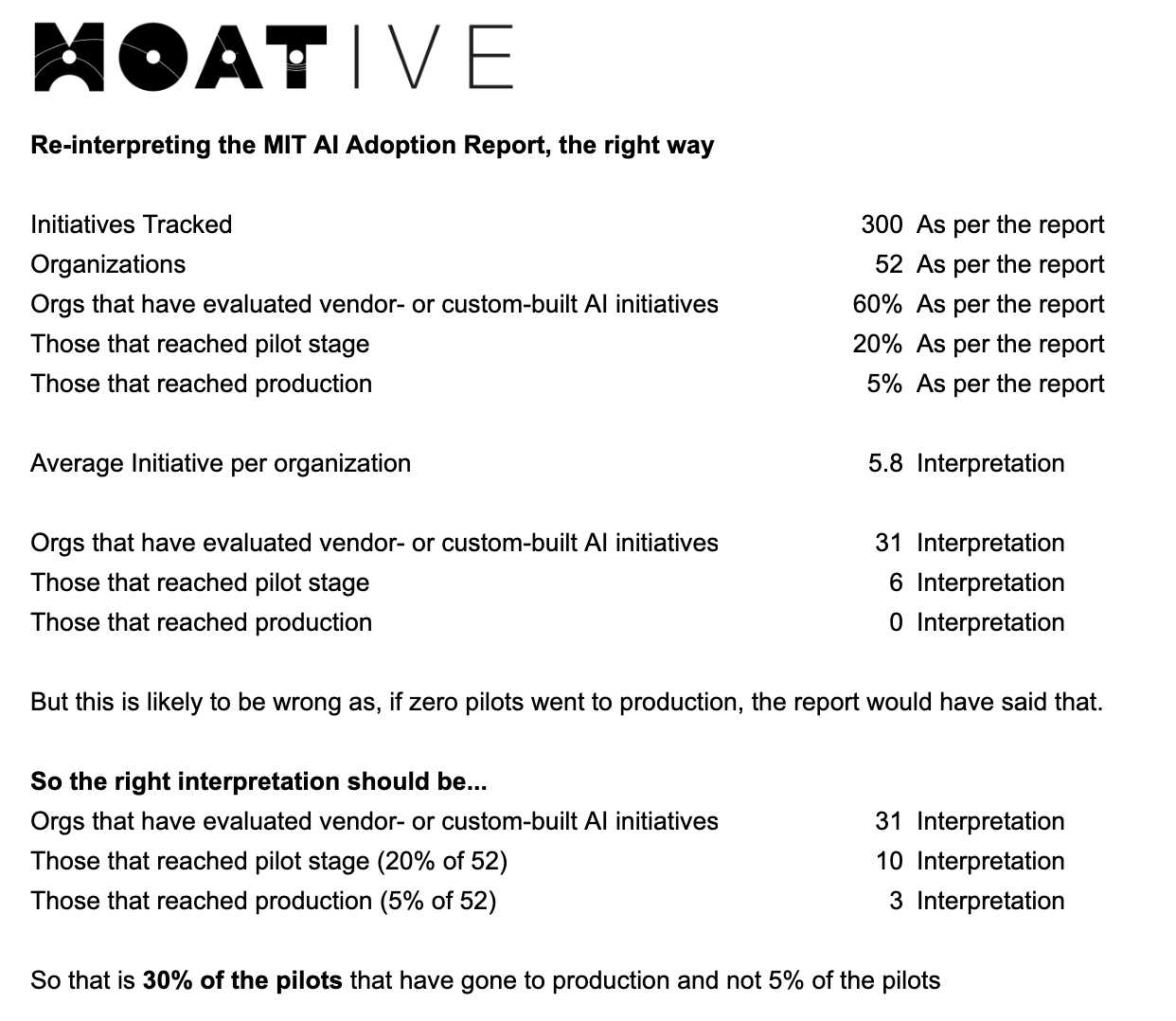
Comparing the GenAI Enterprise Adoption to the other waves
I fully consider that statistics can be bent to suit narratives, as it has been done in this report.

Disclaimer: I am biased. Not only is Moative building and taking agents to production, we also bet on non-linearity and spin out companies or partnerships with ‘outcome-share’ models. We want this wave to succeed. So I understand if you have already pinched the salt.
Let’s look at history, which does not care about my emotions or your board room’s restlessness after reading the MIT report.
1980s and Expert Systems
Experts systems were AI, 40 years back.
Despite an AI boom in the mid-1980s, when companies poured over $1 billion into developing expert systems, most initiatives failed to deliver lasting value. Early successes (like the XCON system at DEC) led to widespread enterprise adoption by 1985, but these rules-based systems proved brittle and expensive to maintain. By the early 1990s, AI’s grand promises hadn’t materialized, causing a collapse in enterprise interest. This “AI winter” saw many corporate AI divisions shut down as expert systems were abandoned due to their inability to learn or handle exceptions. The success rate of AI projects peaked in the 1980s at maybe ~10–15% and then plummeted near zero by the 1990s, exemplifying a wave that stalled after early hype.

Now, even a brittle ‘back in the day’ AI had 15% adoption before it completely failed. Enterprises have learnt how to approach data over the last 10 years. The data lakes are either in place or at least mature enough that they can be put in place with reasonable, predictable success. And yet, only 20% have piloted. It’s exactly the same as Expert Systems but we have better enterprise data foundation systems.
As you sip through your latte, unmindful of the lactose regurgitation that’s on the way, you tell me if this wave of GenAI adoption for custom work in an enterprise is just us regurgitating what we did 40 years ago? At 30% pilot to production conversion rate?
Moving on, let’s look at another wave.
1990s and the ERP wave that bankrupted companies
Enterprise Resource Planning (ERP) suites emerged in the 1990s as “an exotic beast” promising an integrated solution for all businesses. Early adoption was cautious – by the mid-90s only a small fraction of firms had fully implemented ERP. Failure rates were alarming: one study found only ~16% of IT projects succeeded in 1994, with large organizations faring worst at just 9%, which is about twice as good as GenAI custom implementations.
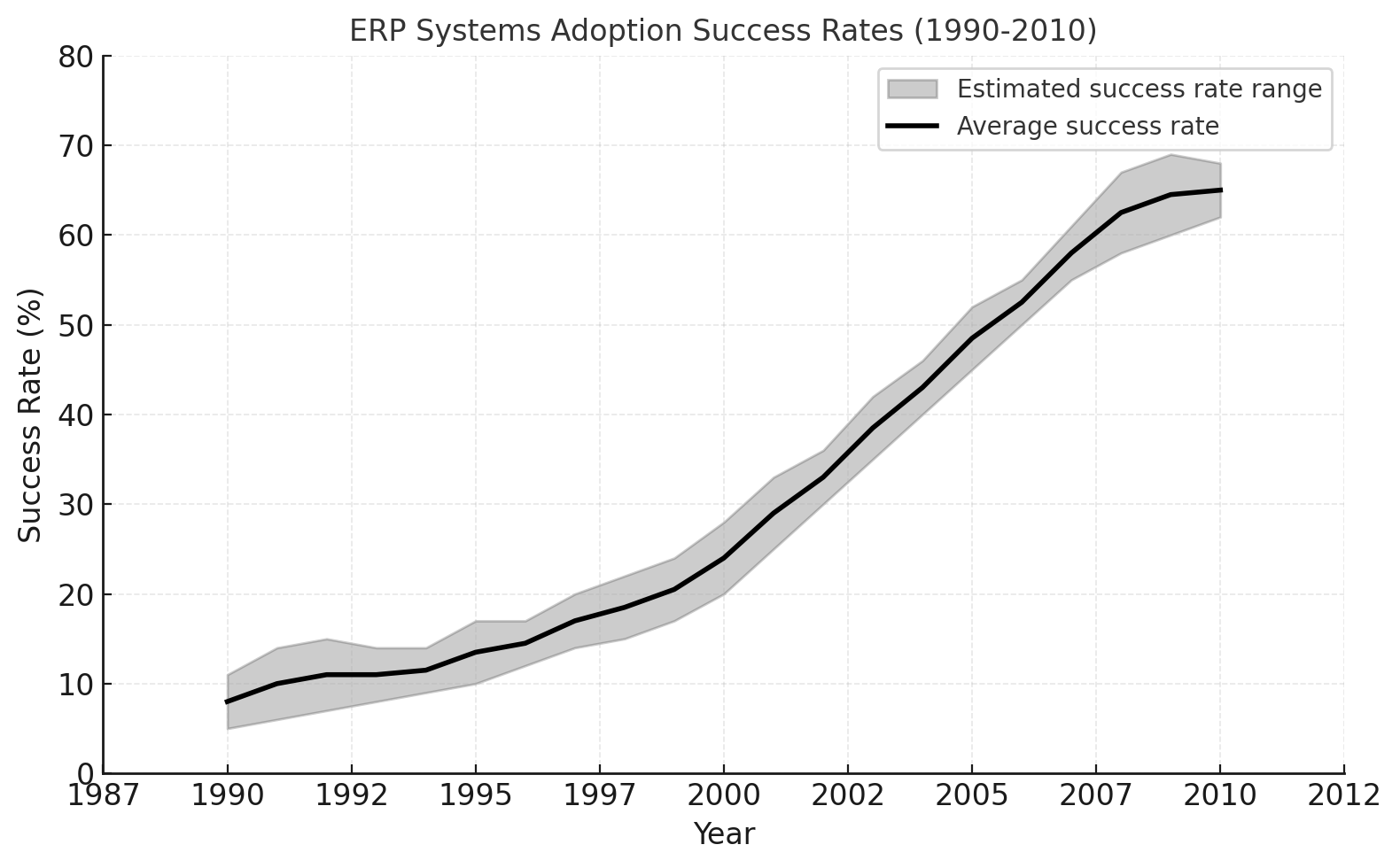
High-profile disasters – Hershey’s stalled SAP rollout in 1999 that delayed candy shipments, or FoxMeyer’s ERP failure contributing to bankruptcy – fueled doom-and-gloom headlines. We are 18 months into enterprise AI adoption. What’s the high profile failure we can think of or who went bankrupt because AI swiped all the profits and invested in crypto?
The ERP wave thus took over a decade before a majority of enterprises saw successful outcomes (50-60%), after early years rife with high-cost failures. But walk into any manufacturing company and ask them how good their ERP is. If you are data-minded, find what is the ‘Total Factor Productivity’ of enterprise tech for manufacturing companies? It’s been flat for the last 15 years. No, the ERP didn’t move the needle even at 50% success rates.
The GenAI wave is neither as spectacular as ERP was in terms of failures, nor would it be as lacklustre as ERPs are 30 years into adoption. We are just bad at estimating the value unlock. We were good at rolling in SAP into a $50M fastener company, shooing them away to spreadsheets forever. We are good at mainstream-ing ERPs even though no one likes it and the value is nebulous. We are now talking AI-first ERPs already.
Predictions are biased, ‘point-in-time’ sentiments and rarely play out the way it’s predicted. I say that the 30% pilot-to-production is not spectacular because ‘going to production’ is not the gold-standard. It takes a year or more to realize true value and then take it in real numbers to the balance sheet. Let’s wait.
Remember SOA?
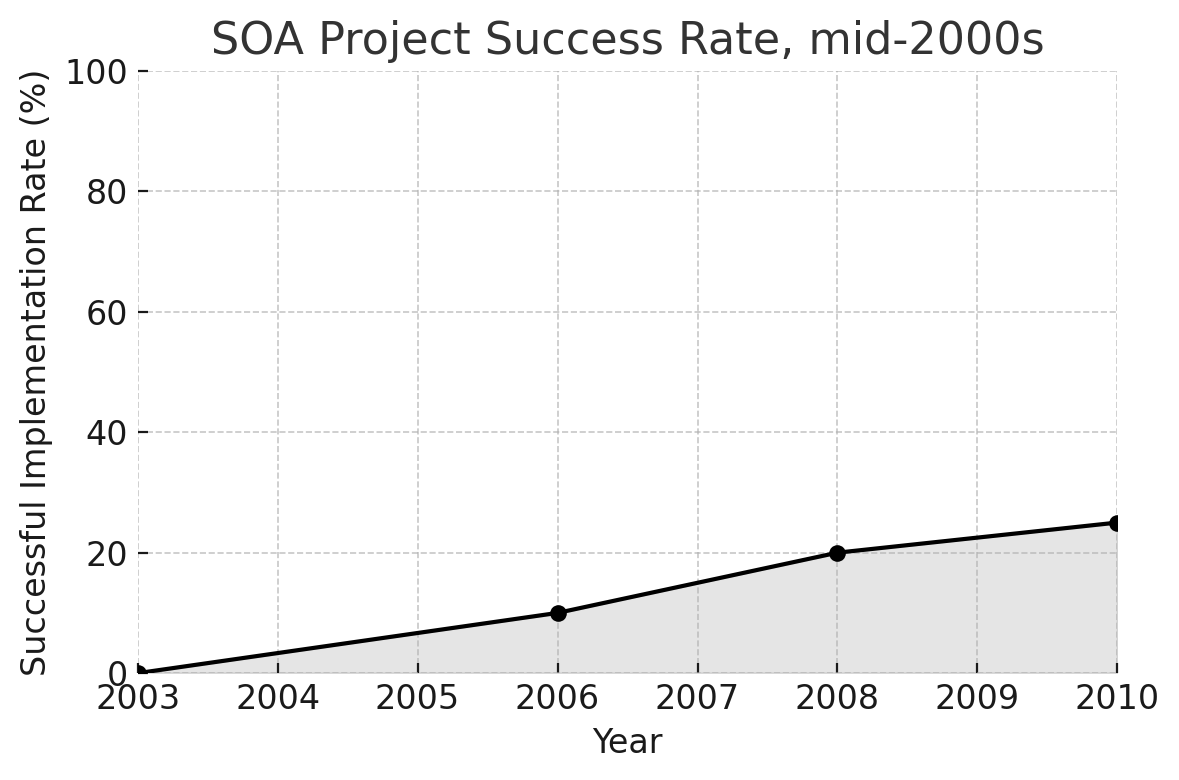
Same story. But microservices and APIs emerged out of this wave. Could we have skipped this wave? No. It was foundational at the level of architectural principles. Software AG, a popular name during the SOA wave still managed to sell WebMethods to IBM as recently as 2023.
It’s 2025. No one debates cloud and yet…
When cloud computing arrived around 2006–2008, enterprises were initially cautious. Early adoption was slow – a 2010 poll found only 7–9% of enterprises had implemented cloud in any form.
4 years into the wave only 9% went to production. That is what GenAI adoption for custom work in enterprise looks like today. By the mid-2010s, cloud adoption took off – companies overcame initial issues and started migrating core systems. It took roughly 8–10 years from the early hype for cloud to achieve majority adoption (>50%). The cloud wave demonstrates how a paradigm can go from skeptical slow uptake (with consultants warning of failures) to essentially ubiquitous infrastructure, once challenges are addressed.
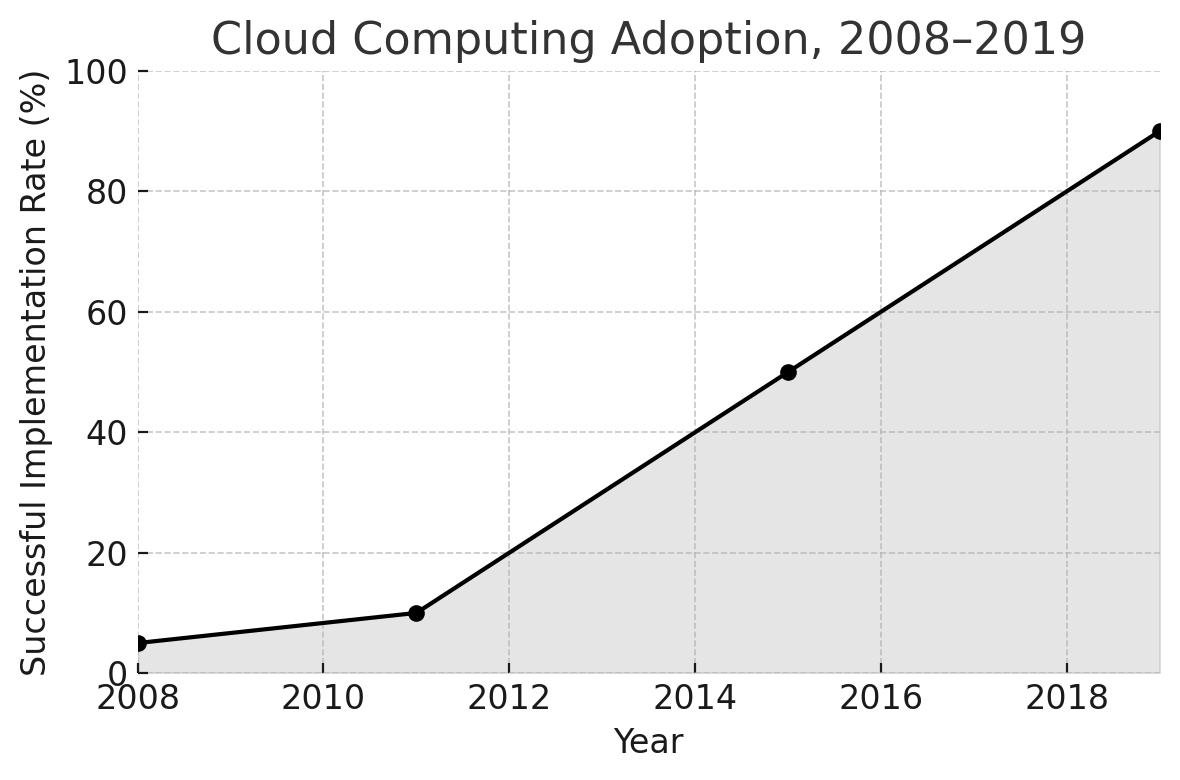
Could we skip the failure part and directly go to glory? Well, I too want flying taxis but instead I have range anxiety. But I believe drones already have seats and I even spotted one right across my home, where my uni is building an air ambulance and got a $1B order from the government. Take that SaaS!
Continuing with the (block)chain of thought…
Do you know what blockchain is? It will make network state possible very soon. We will all have digital visas and everyone will be able to verify everyone else and we will live in a trusty La-la land enabled by a trustless paradigm. Sorry, I am too skeptical about a wave whose time will come soon.

But it’s important to talk about this wave. It never took off. 95% percent of the initiatives failed even after 5 years.
Closing Thoughts
Read the reports. But remember that every wave was a failure until it was not. You cannot be too early into a wave (like Blockchain) but you cannot be too late as well, into general purpose tech like AI.
See there is a difference between SOA, ERP and Generative AI. Today I know of companies at $100M that don’t have an ERP. That is ok, because these are tools and not general purpose technology that can fundamentally alter how work is done. GPT is a GPT (General Purpose Tech) much like steam engine is.
I am sure World War heroes started a bunch of locomotive companies and many of them had false starts before things took off. Imagine, if the UK had said “Nah, let me stick to horse carriages!”